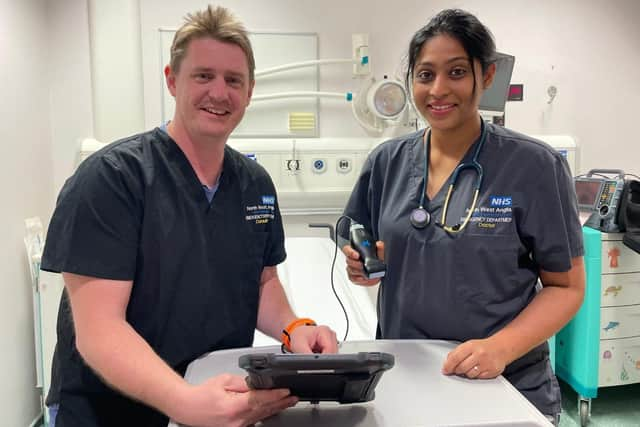Emergency medicine trainees at Peterborough City Hospital trial new body imaging device
and live on Freeview channel 276
Trainees in emergency medicine at Peterborough City Hospital are among the first in the county to be trialling the use of innovative portable ultrasound devices to assess patients faster than before.
These portable devices are used for point of care ultrasound (POCUS) training and allow trainees to learn how to undertake POCUS assessments by providing the opportunity for immediate feedback.
Advertisement
Hide AdAdvertisement
Hide AdOnce trained, it allows trainees to use ultrasound in a wide range of emergency situations to enhance clinical assessment and allow specific questions to be answered while at the bedside.


The ‘Butterfly’ ultrasound systems have been introduced as a training tool by Toby Edmunds, a consultant in critical care, emergency medicine and pre-hospital emergency medicine, based at Peterborough City Hospital.
Dr Edmunds joined North West Anglia NHS Foundation Trust just over a year ago having trained in the North of Scotland.
He also flies regular shifts with the East Anglian Air Ambulance (EAAA), where is he is the ultrasound lead; having developed a governance system to ensure safe use of the same type of device that has been introduced at the Peterborough City Hospital Emergency Department.
Advertisement
Hide AdAdvertisement
Hide AdHe said: “EAAA have used the Butterfly ultrasound device for around four years and seen huge benefits to patient care from it. I have introduced this as a training tool for the emergency medicine trainees in Peterborough in the hope we can make these skills more accessible.
“Trainees can scan a patient and receive educational guidance within 48-72 hours. This is a great example of the Trust using technology to improve the trainee experience.”
Among the trainees using the device is Dhanya Sebastian, a ST4 emergency medicine doctor. She said: “Because of its size and the fact that it is portable, the Butterfly is very user friendly.
“It speeds up the process for the consultants and the trainees, and having Dr Edmunds, who is efficient and knowledgeable in using the Butterfly, provides us with ‘real time’ feedback and on the job learning.”
Advertisement
Hide AdAdvertisement
Hide AdDr Edmunds’ combined role allows him to be involved at the start of a patient’s care pathway, from their immediate care either on the scene or at arrival in the emergency department through to delivery of their critical care needs.
His work with the EAAA, has seen him attend the scene of some traumas ranging from construction sites and road traffic accidents, often in challenging or hostile environments.
Dr Edmunds added: “I love my job and feel very privileged to be working in a role that allows me help care for some of the sickest patients in the region.”
He added: “It is only possible to do my job by working within and with teams of amazing clinicians to overcome the challenges of delivering medicine and medical care in any environment.”